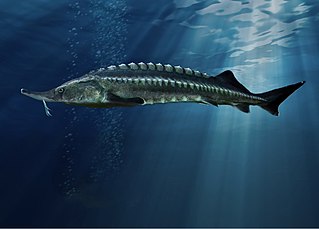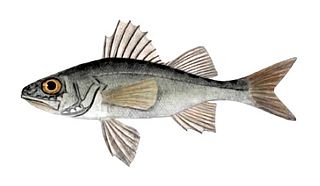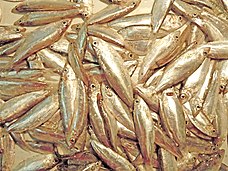
The Sea of Azov is an inland shelf sea in Eastern Europe connected to the Black Sea by the narrow Strait of Kerch, and is sometimes regarded as a northern extension of the Black Sea. The sea is bounded by Russia on the east, and by Ukraine on the northwest and southwest, currently under Russian occupation. It is an important access route for Central Asia, from the Caspian Sea via the Volga–Don Canal.

The Caspian tern is a species of tern, with a subcosmopolitan but scattered distribution. Despite its extensive range, it is monotypic of its genus, and has no accepted subspecies. The genus name is from Ancient Greek hudros, "water", and Latin progne, "swallow". The specific caspia is from Latin and, like the English name, refers to the Caspian Sea.

Sprat is the common name applied to a group of forage fish belonging to the genus Sprattus in the family Clupeidae. The term also is applied to a number of other small sprat-like forage fish. Like most forage fishes, sprats are highly active, small, oily fish. They travel in large schools with other fish and swim continuously throughout the day.

The beluga, also known as the beluga sturgeon or great sturgeon, is a species of anadromous fish in the sturgeon family (Acipenseridae) of the order Acipenseriformes. It is found primarily in the Caspian and Black Sea basins, and formerly in the Adriatic Sea. Based on maximum size, it is the third-most-massive living species of bony fish. Heavily fished for the female's valuable roe, known as beluga caviar, wild populations have been greatly reduced by overfishing and poaching, leading IUCN to classify the species as critically endangered.

Dreissena is a genus of small freshwater mussels in the family Dreissenidae in the class Bivalvia. They are found attached to firm substrates by threads from underneath the shells and are the only freshwater bivalves to attach to hard substrates in high densities while having a planktonic larval stage. They are considered the most aggressive freshwater invader in the world because of their ability to invade environments in every one of their life cycle.

The European sprat, also known as bristling, brisling, garvie, garvock, Russian sardine, russlet, skipper or whitebait, is a species of small marine fish in the herring family Clupeidae. Found in European, West Asian and North African waters, it has silver grey scales and white-grey flesh. Specific seas in which the species occurs include the Irish Sea, Black Sea, Baltic Sea and Sea of the Hebrides. The fish is the subject of fisheries, particularly in Scandinavia, and is made into fish meal, as well as being used for human consumption. When used for food it can be canned, salted, breaded, fried, boiled, grilled, baked, deep fried, marinated, broiled, and smoked.

The sterlet is a relatively small species of sturgeon from Eurasia native to large rivers that flow into the Black Sea, Azov Sea, and Caspian Sea, as well as rivers in Siberia as far east as Yenisei. Populations migrating between fresh and salt water (anadromous) have been extirpated. It is also known as the sterlet sturgeon.

The starry sturgeon also known as stellate sturgeon or sevruga, is a species of sturgeon. It is native to the Black, Azov, Caspian and Aegean sea basins, but it has been extirpated from the last and it is predicted that the remaining natural population will follow soon due to overfishing.

The Russian sturgeon, also known as the diamond sturgeon or Danube sturgeon, is a species of fish in the family Acipenseridae. It is found in Azerbaijan, Bulgaria, Georgia, Iran, Kazakhstan, Romania, Russia, Turkey, Turkmenistan, and Ukraine. It is also found in the Caspian Sea. This fish can grow up to about 235 cm (93 in) and weigh 115 kg (254 lb). Russian sturgeon mature and reproduce slowly, making them highly vulnerable to fishing. It is distinguished from other Acipenser species by its short snout with a rounded tip as well as its lower lip which is interrupted at its center.

Alosa maeotica, known as the Black Sea shad or Azov shad, is a species of clupeid fish endemic to the Sea of Azov and the western part of the Black Sea basin. It is found in Bulgaria, Georgia, Moldova, Romania, Russia, Turkey, and Ukraine.
Abrau sprat, Clupeonella abrau, is a species of freshwater fish in the family Clupeidae. It is found landlocked in Russia in a single locality, Lake Abrau, located at 70 m above sea level near the Black Sea coast close to Novorossiysk. The lake is small and has been stocked by several alien species, whence the Abrau sprat is considered critically endangered.

Clupeonella is a genus of fish in the family Clupeidae. They are widespread in the fresh and brackish waters of the Caspian Sea and Black drainages.

Common percarina is a species of fish in the family Percidae. It is found in northwestern Black Sea basin in estuaries and coastal lakes, and in the lower reaches of the rivers that drain into that part of the Black Sea. It is a carnivorous species.

The European anchovy is a forage fish somewhat related to the herring. It is a type of anchovy; anchovies are placed in the family Engraulidae. It lives off the coasts of Europe and Africa, including in the Mediterranean Sea, the Black Sea, and the Sea of Azov. It is fished by humans throughout much of its range.

Alosa caspia is a species of clupeid fish, one of the species of shad endemic to the Caspian Sea basin.
Caspian tyulka, Clupeonella caspia, is a species of fish in the family Clupeidae. It is found in the Caspian Sea, also in the lower reaches of the rivers Volga, Ural, and possibly Terek. This is a brackishwater pelagic-neritic fish, up to 12 cm maximum length.
The freshwater tyulka is a species of fish in the herring family Clupeidae. It is found in the Caspian Sea watersheds, including the lower reaches of the rivers Volga and Ural. It was introduced to the Don River basin and is also invasive upstream in the Volga drainage. It is a small freshwater pelagic fish, up to 10 cm maximal length, inhabiting large lakes and reservoirs, and breeding in open water. Earlier it was considered to be a part of the species Clupeonella cultriventris.
Southern Caspian sprat, Clupeonella grimmi, is a species of fish in the family Clupeidae. It is found in the brackishwater Caspian Sea, in its central and southern parts in the pelagic zone. It is a small fish, typically 11 cm length, and up to 14.5 cm maximum. Occurs not deeper that 32 m depth.

Azov percarina is a species of ray-finned fish in the family Percidae.
Clupeonella muhlisi is a species of clupeid fish endemic to Lake Uluabat in Turkey, linked to the Sea of Marmara.

















